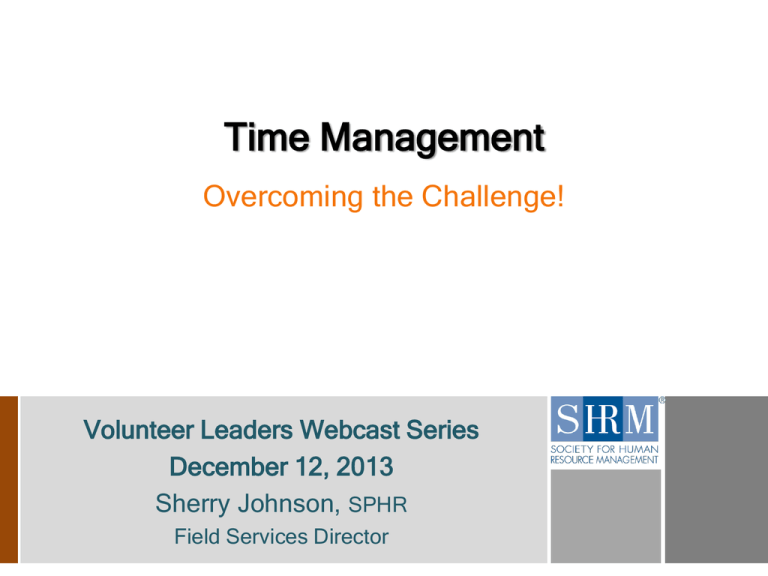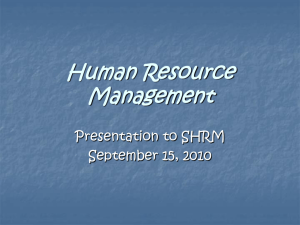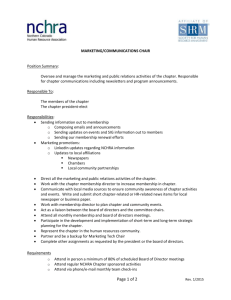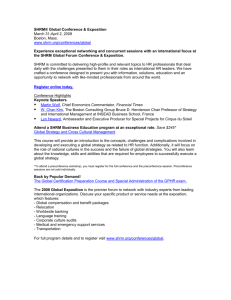Time Management and Work / Life Balance
advertisement

Time Management Overcoming the Challenge! Volunteer Leaders Webcast Series December 12, 2013 Sherry Johnson, SPHR Field Services Director Today’s Agenda 1. Where we stand with time today 2. Determining where your time goes 3. Prioritizing and work/life balance 4. The power of delegation 5. Ensuring clear communication 2 Time Management and Work / Life Balance Overcoming the Challenge! “No one has enough time, but everyone has all there is.” - Anonymous 3 The Pareto Principle 80/20 Rule Are you feeling overwhelmed? It’s time to organize and simplify your life! 4 Parkinson’s Law The demand upon a resource tends to expand to match the supply of the resource. 5 Analyze How You Spend Your Time Activity Start Time Finish Time Time Spent Planned Activity? Notes Telephone Calls Scheduled Interviews Employee Meetings Walk-in Interviews Special Projects Other 6 The Future Comes Soon Enough “ I never think of the future. It comes soon enough.” - Albert Einstein 7 Using Key Goals to Focus on Your Priorities 8 Strategies for Optimizing Your Work Day 9 Strategies for Optimizing Your Work Day 1. Balance your work and leisure time 2. Set your priorities 3. Manage your e-mails & telephone calls 4. Control interruptions 5. Schedule time for your work day 6. Delegate! 7. Find an organization system that works – and stick with it! 8. Handle paper once 9. Break a project into actionable pieces 10. Identify and challenge things that waste time and effort 11. Recondition the expectations of others 12. Batch routine work 13. Work in uninterrupted blocks of time 14. Re-clarify goals and priorities – daily! 10 Work / Life Balance 11 Slaves to the Clock 12 Ready, Set, GO! 13 Have the Discipline to Stay Focused 14 Delegation 15 Why to LEADERS delegate? 16 The 10 Keys to Successful Delegation 1. Define the task 2. Select the individual 3. Assess ability and training needs 4. Explain why 5. State required results 6. Identify required resources 7. Agree on schedule 8. Support and communicate 9. Provide feedback on results 10. Repeat the process 17 Communicating 18 The Employee “Voice” Figure 1: Organizational Communication Poll HR Professionals 3.00 Employees My organization listens to what its staff has to say. 2.86 2.64 My organization addresses the issues that are most important to me. 2.65 2.37 My organization is open to suggestions and improvements offered by employees. 2.74 Note: Averages are based on a scale where 1 = strongly disagree and 4 = strongly agree. Source: Parks, M. (2005). SHRM/CareerJournal.com 2005 organizational communication poll findings. Retrieved July 6, 2007, fromwww.shrm.org/Research/SurveyFindings/Pages/default.aspx. 19 Communication Tips 1. Allow employees to question 2. Be clear and concise 3. Be open and honest 4. Use appropriate communication medium 5. Transmit the correct information 6. Adapt communication to reflect culture 20 Impact of Effective Communication Fast Fact • The 2003/2004 Watson Wyatt study found that high levels of effective communication have a positive impact on employee turnover. • According to the study, companies that communicate effectively are more likely to report turnover rates below those of their industry peers that communicate less effectively (33.3 % versus 51.6%, respectively). Source: 2003/2004 Watson Wyatt Effective Communication ROI Study— Connecting Organizational Communication to Financial Performance. 21 Empowering Employees 1. Meaning: the importance of an employee’s work 2. Competence: belief in capacity to perform tasks 3. Self-determination: offering employees more control 4. Impact: value employee opinions 22 Summary 1. We have all the time there is, we need to use it! 2. Evaluate where your time goes 3. Set priorities around how you work 4. Delegate and empower your employees 5. Make your communication clear 23 Resources • Article available on the SHRM Volunteer Leaders Resource Center (VLRC), “Management Series Part I: Time Management Skills-Optimizing Your Effectiveness” http://www.shrm.org/Research/Articles/Articles/Pages/Management_20Series_20Part_20I__20 Time_20Management_20Skills-Optimizing_20Your_20Effectiveness.aspx • “Time Management Training,” available through the SHRM Store; includes a companion CD-ROM with ready-to-use presentations and electronic copies of all supporting material http://shrmstore.shrm.org/time-management-training.html • Articles on the topic of “work/life balance” available on the SHRM website http://www.shrm.org/searchcenter/Pages/Results.aspx?k=w ork/life%20balance • “Workplace Flex Toolkit” recently published on the SHRM Workplace Flexibility Resource Page http://www.shrm.org/hrdisciplines/benefits/Pages/workflex.as px 24 Going Forward – Look to SHRM for Support www.shrm.org 25 Questions 26 Thank you! Sherry Johnson, SPHR Field Services Director sherry.johnson@shrm.org 703-535-6255 (W) @SHRMSherry www.shrm.org 27



